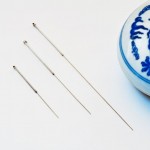 In China, rheumatism belongs to the bi category – meaning “painful obstruction,” which causes such symptoms as pain, numbness, paralysis, lack of sensation, and stiffness.
In China, rheumatism belongs to the bi category – meaning “painful obstruction,” which causes such symptoms as pain, numbness, paralysis, lack of sensation, and stiffness.
The closest Chinese medicine term is fēngshī bing, which literally means “Wind-Damp disease.” And the Wind and Damp factors can complex with either Cold or Heat factors to yield arthralgia.
Rheumatoid arthritis and Chinese medicine
According to Chinese medical theory, there are three key pathological factors…
Wind (fēng) refers to the sudden onset of the disease, mobility of the affected site, variability of the manifestation of symptoms, and sensitivity to changes in the environment.
Wind-dominant arthralgia most often affects the upper body and corresponds to the early stage of Rheumatoid Arthritis (RA).
Deficiencies allow Wind to more easily penetrate the body and cause pain.
Damp (shī) refers to the worsening of the symptoms in damp weather, the initiation of the disease, or worsening of symptoms after spending time working in a wet environment, and the accumulation of fluid in the joints and/or nearby areas of the limbs.
Dampness-dominated arthralgia most often affects the lower part of the body and is characterized by swelling and stiffness of the joints, and accompanying sensations of numbness. It may correspond to a middle stage of RA (after the disease has become chronic, with less variability of affected joints).
Disorders of the fluid metabolism will aggravate dampness and the resulting joint dysfunction.
Cold (hán) refers to the worsening of symptoms with exposure to cold, improvement by applying heat (including liniments that increase local circulation), and impaired circulation (that most often occurs with aging).
It especially affects the extremities (hands and feet) where circulation is poorest, as well as the lower back.
The Kidney Yang is responsible for warming the body and, if deficient, is unable to dispel chilliness. Exposure to cold may initiate arthralgia; however, the more common association is with advanced arthritis in which the internal metabolism (Qi and Yang aspects) are debilitated by chronic disease and aging, yielding a Cold syndrome.
Treating RA with Chinese medicine
In treating painful obstruction, basic TCM principles are used:
- warming what is Cold
- cooling/clearing Heat
- eliminating what is lodged (Pathogens such as Dampness, Phlegm, or Blood Stasis)
- and tonifying what is Deficient (Qi, Yang) to eliminate pathogenic factors.
Acupuncture regulates the immunologic function of the body by enhancing body resistance and eliminating pathogenic factors.
Acupuncture dredges the channels and collaterals (major and minor meridians), thereby promoting blood circulation to remove blood stasis and relieving inflammation to stop pain by improving blood viscosity and inhibiting platelet aggregation.
Why herbs are useful
The mechanism of action that may be dominant in situations with good therapeutic results using herb formulations is a reduction in the levels of pro-inflammatory cytokines, such as interleukin-1 (IL-1).
The effect is to then alter the T-cells and the production of activated antibodies and other components.
In addition, the properties of the blood and its circulation also change, with lowered sedimentation rate and improved circulation to the extremities. Chinese herb formulas also act on the prostaglandin synthesis and degradation pathways, yielding a lower level of pro-inflammatory prostaglandins.
Recommendations
Eat more sulfur-containing foods. such as:
- asparagus
- eggs
- garlic
- onions
Sulfur repairs and rebuilds bone, cartilage, and connective tissue, and it also aids in the absorption of calcium.
Eat dark, green, leafy vegetables, nonacidic fresh fruits, whole grains (rice, wheat, rye; contain histadine – good for removing excess metals from the body), oatmeal, brown rice, fish (deep sea only for higher levels of oils), soybean products, avocados.
Hot castor oil packs can be beneficial if heat improves pain.
For hot pain, use cold gel packs.
Mineral salt hot baths can ease pain and increase mobility in the morning.
Perform regular, moderate exercise — practice yoga, Taijiquan, or Qi Gong for proper Qi circulation and balance. Avoid eating cold/raw foods as they require more digestive fire/energy and add Cold to the body. Eat warm, cooked meals – one pot meals are best as they are easily digested and nutrient dense.